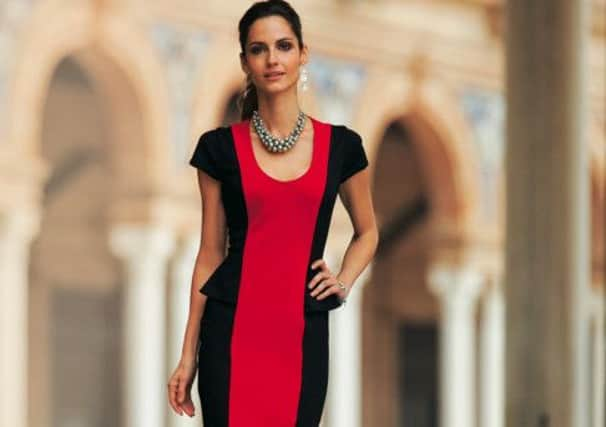Dresses fit to flatter


Morning TV presenters love them, especially weather presenters, who can’t get enough of them. Small wonder that they have become the new ubiquitous workwear staple.
How on earth did we ever manage before the dawn of the panelled bodycon shift dress? It can’t have escaped the notice of even the least enthusiastic followers of female fashion that tight-fitting dresses made up of strategically placed panels, usually in two contrasting shades, have come to dominate women’s smart daywear.
Advertisement
Hide AdAdvertisement
Hide AdAs an example, let’s say the dress is in black and caramel. The black panels are typically placed running down the sides, while the lighter caramel colour takes a central vertical panel. This has the happy effect of creating the visual illusion that the body is narrower than it really is, shaving inches off hips when looked at straight on, but also flattering when viewed from the side, too. It’s really rather clever (although a similar effect can be achieved with a narrow, tightly fastened apron – ust in case the opportunity arises).
Anyway, in the main, these panelled, body-conscious shift dresses are constructed in fairly robust fabrics, which pull in the flesh, corset-style, and if you are not used to clothes that cling, you might find them a little on the uncomfortable side. Plus you do need the correct underpinnings because lumps and bumps do not magically disappear, especially in a nude or light-toned fabric, so make sure you have on your Spanx, magic pants or line-smoothing all-in-ones, plus a pair of sturdy body-shaping tights.
If you haven’t tried one yet, it is worth experimenting with panelled monochrome and colour-block dresses (and skirts and tops) to see which positioning of panels suits you best. There are some styles that keep the skirt plain and one colour, but have top half-fashioned with panels that work to contour the upper body – potentially excellent for top-heavy and apple shapes, especially if you look for scoop necklines and small slivers of panels, cut in to bring the shoulders together and make the chest look neater and more compact.
Almost all panelled dresses strive to make the waist look narrower and pull in and minimise the tummy area, as this does appear to be what even the slimmest of women want to tackle.
Advertisement
Hide AdAdvertisement
Hide AdPerhaps the most popular style, however, is the panelling that works to minimise the whole torso, hips and upper legs, with a lighter or brighter panel running centrally vertical, bordered by dark panels.
This can be very effective, and flattering on shapely, curvy and some fuller figures, but do bear in mind that, if you are already very slim, it’s probably not a style that will work well on you (interestingly, these sort of dresses have not been shown off to their best advantage on tall, skinny models, who often just look flat and slightly desperate in them).
Don’t forget other tried and tested styles of dress that flatter. Wrap dresses suit most figures, especially pear shapes, lengthening the top torso with a v-neck while skimming tummy and hips.
Loose-fitting, floaty, kaftan and kimono-style dresses can be astonishingly glamorous and flattering, if you look for ones that tie, Grecian-style, just under the bust.
As ever, when in doubt, look to the classics.
Twitter: @yorkshirefashQ